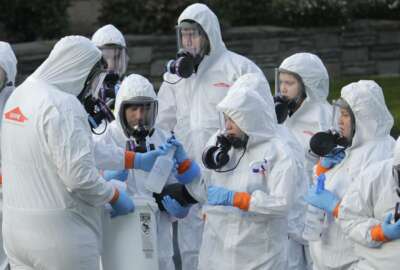
Lack of transparency, communication leaving some feds frustrated over telework plans
Federal employee are expressing anger and fear over a lack of planning around telework by their agencies to deal with the coronavirus outbreak.
Despite multiple memos from the Office of Personnel Management and a new one from the Office of Management and Budget, federal employees are growing more frustrated every day with a lack of a governmentwide plan or approach to telework as fears of the coronavirus rise.
Over the last week, some agencies have acted more swiftly to either mandate or give employees broad options to telework due to the spread of COVID-19, the illness caused by the current strain of the coronavirus. But large citizen facing agencies like the Social Security Administration, the Small Business Administration and others remained wedded to current telework policies. Many agencies, including the departments of Interior and Agriculture, have reduced the number of days eligible federal employees can work from an alternative location over the past few years and haven’t yet changed that policy. The Education Department just on March 13 relaxed its more restrictive telework policy, telling eligible employees to take their laptops home nightly to ensure they can work from alternative locations if necessary.
SSA also just changed its policy on March 13 to give employees more flexibilities to care for loved ones or as part of the high risk categories, as well as reverting back to pre-March telework schedules.
OMB’s March 12 memo encouraged agencies to let certain vulnerable populations, such as those people over 60 years, pregnant women and people with underlying health conditions, work from home, but the administration didn’t offer a broad edict for all federal employees.
This lack of consistency across the government is creating frustration and concern among employees.
To be clear, OPM cannot mandate telework for every agency as it’s a decision that must be made by each individual secretary.
Federal News Network compiled comments sent in by email, from social media platforms and through interviews that demonstrate the growing anger across the government.
SSA employee: “When the Super Bowl was in Atlanta, the entire regional office teleworked for over a week to ease congestion and enhance security. It also teleworked for the NCAA football championship game for the same reasons. Why will the agency allow telework for the Super Bowl but not when potential lives are on the line?”
NIH employee: I am concerned that it will take the infection (and god-forbid) death of an NIH patient or employee for HHS to consider a policy change. How many thousands of federal employees are being asked to endanger themselves and their neighbors to satisfy the irrational ego of the head of the executive branch?
If Maryland’s Governor tells Maryland State employees to telework, why are federal agencies located in Maryland telling their employees it’s not dangerous enough to allow telework?
What do agency heads know about the coronavirus, more than Maryland’s own Governor knows?
— Craig (@Craig_543) March 12, 2020
I was told today that I could not telework “until word comes from the White House” that federal employees can.
— Melissa (@MsMelsBells) March 12, 2020
Same thing our agency told us and in the past they had no problems granting telework and even closed the office on numerous occasions ordering employees to telework due to weather concerns
— HunterBean (@HunterB41039246) March 12, 2020
Exactly. We get to do unscheduled telework any time it MIGHT snow but for some reason NOW we are being told we must have high level special permission to work from home any more than our 2 already scheduled days a week. Unbelievable
— a (@arfg512) March 13, 2020
From Facebook:
“Be nice if this was actually being widely practiced. I work in the Jackson Federal Building, downtown Seattle. An employee in a different function was exhibiting symptoms, and started a 14 day self-quarantine. Realizing that they didn’t have enough sick leave to cover the entire absence, they requested advanced sick leave. The request was denied and they were given AWOL instead. So, they returned to work, unable to afford an extended period without pay and afraid of potential disciplinary action for extended AWOL. They have now tested positive for the virus. There are additional employees exhibiting symptoms. You would think that agencies in a federal building at the center of the largest concentration of cases in the country would be more likely to comply with the OPM and HCO recommendations, but I guess not. Now the several thousand employees still coming into the building every day are wondering how many more cases there will be.”
Here are the most recent telework statistics from OPM’s 2017 report to Congress.
| Number of employees teleworking | Percentage of eligible employees teleworking | Percentage of employees teleworking | |
| Agency | |||
| USDA | 32,277 | 51% | 34% |
| Commerce | NA | NA | NA |
| Defense | 121,080 | 33% | 15% |
| Education | NA | NA | NA |
| Energy | 6,095 | 44% | 41% |
| HHS | 40,333 | 76% | 47% |
| DHS | 27,069 | 45% | 14% |
| HUD | 5,405 | 81% | NA |
| Interior | NA | NA | NA |
| Justice | 8,338 | 22% | 7% |
| Labor | 11,698 | 77% | 77% |
| State | 5,025 | 29% | 20% |
| Transportation | 18,692 | 72% | 34% |
| Treasury | 45,843 | 86% | 48% |
| VA | 31,404 | 64% | 8% |
| EPA | 11,895 | 79% | 79% |
| NASA | NA | NA | NA |
| USAID | 1,919 | 79% | 52% |
| FEMA | 1,784 | 21% | 12% |
| GSA | 9,398 | 83% | 82% |
| NSF | 1,379 | 93% | 93% |
| Nuclear Regulatory Commission | 2,200 | 68% | 68% |
| OPM | NA | NA | NA |
| SBA | 1,559 | 63% | 29% |
Federal News Network also asked every CFO Act agency how they are preparing for a large number of employees to telework. The response by some agencies demonstrates the lack of transparency or poor communication that is leaving federal employees frustrated.
Below are the responses we received from agency spokespeople unless otherwise noted:
Army
This came from a civilian employee who commented on our Facebook page:
“We’re doing a dry run of [telework]. If we don’t need to be at work, then telework. We can still go work until it’s mandatory telework. No official mandatory telework has been given, however we were told yesterday that if we can work from to do so. This is mostly a test to see if it’s doable for our group.”
Commerce Department
Secretary Wilbur Ross and his leadership team are closely monitoring the global outbreak of COVID-19. Department officials will continue to prioritize the health and safety of department employees as they track the evolving COVID-19 situation.
Senior leaders from the department are in communication with the White House Coronavirus Task Force coordinating the whole-of-government response to COVID-19. Guidance is being implemented as it is received from the lead federal partners. The department recommends all employees monitor announcements from their state and local health officials.
The Department of Commerce is preparing for a wide variety of telework scenarios for our employees. Our office of the Chief Information Officer is carrying out a variety of tests to ensure readiness for different scenarios. We constantly monitor our systems and our people to ensure resiliency and operational readiness. These efforts provide the opportunity to refresh staff awareness of telework capabilities, resources and tools. The Department of Commerce is ready to meet our mission should our facilities be impacted by COVID-19.
Defense Contract Audit Agency
A DCAA employee posted on Facebook that the agency has mandated employees take home their laptops each night to be prepared for working remotely if necessary. DCAA also has asked employees to verify telework agreements and contact information.
Environmental Protection Agency
Maintaining the health and safety of EPA’s workforce while fulfilling our mission responsibilities is our top priority. EPA has a robust Continuity of Operations Program and as outlined in the OPM Guidance has a telework-ready workforce with the technology to support it. We regularly use teleworking capabilities to support the EPA workforce in performing the mission of the agency.
FEMA
The federal government is taking aggressive and proactive steps to mitigate the spread and effects of the coronavirus (COVID-19). Consistent with its mission, FEMA has also been promoting preparedness activities as part of the federal government’s coordinated response to COVID-19. Part of those ongoing planning efforts includes an Agency-wide connectivity drill to establish our ability to perform our mission while working remotely. The health and safety of FEMA employees and the American population as a whole is a top priority, and we continue to follow the recommendations of the CDC and other federal authorities to protect our workforce.
Department of Health and Human Services
The Office of Personnel Management (OPM) guides all federal agencies regarding workforce flexibilities, including telework, and has put out telework guidance related to COVID-19. The response to COVID-19 is a rapidly evolving situation and HHS is working with state and local health officials to ensure that all proper workplace flexibilities are utilized to protect our employees.
An HHS employee commented on Facebook, however, that the policy seems to have been updated:
“HHS has instructed us to do this as well. I’m ready for OPM to pull the trigger on this whole telework thing.”
Department of Housing and Urban Development:
“HUD is conducting, and will continue to conduct, stress tests on our systems and make any modifications needed, as well as working with employees to ensure they are telework ready.”
Department of Justice
The Department of Justice is in the process of testing the organization’s telework resiliency, starting with ensuring that appropriate telework agreements are in place, assessing our capacities, and encouraging staff to test their mobile devices and remote access connections. The epartment components have been given flexibility to test on their own schedules, working closely with the Office of the Chief Information Officer, said DoJ acting chief information officer Melinda Rogers.
Department of Labor
The department takes the health and safety of its employees seriously. DOL Agency Heads are reviewing their Agency continuity of operations (COOP) plans to ensure that telework has been fully incorporated and that employees are appropriately identified as telework participants in the plan.”
Nuclear Regulatory Commission
The NRC is testing the telework readiness of its workforce on March 13. NRC management is relying on Office of Personnel Management guidance and has reviewed the agency’s COOP procedures while considering what actions related to the coronavirus might be warranted going forward.
Substance Abuse and Mental Health Services Administration
A reader shared an internal note from the SAMHSA’s leadership:
We wanted to provide you an update on our efforts regarding COVID-19. First, I want to state again that your health and safety are of utmost importance to the Office of the Assistant Secretary. Due to the progression of the virus, we have been granted additional telework flexibilities. If you have portable duties and the technical ability to telework and fall into any one of these categories, you are being given the option to request telework for the next two weeks. (We will increase if needed). Please make a request to your supervisor in writing (email stating “I wish to episodically telework full time for the period of March 16-March 27th due to the fact that I am an employee over 60, which CDC has recognized as a vulnerable population). The eligible categories are:
1. Employees who are over 60
2. Employees who have chronic health condition
3. Employees who believe they may have had contact with someone infected
4. Employees who are affected by school closures
Again, if you fall into one of these categories, and wish to telework full-time from the period of March 16-March 27, please contact your supervisor via email immediately.
Regarding those who may be home due to school closures, we have been granted flexibility to allow employees to telework even if they have dependents at home.
However, we do need to properly account for the time so when you are not able to work due to needing to care for your child, you will need to let us know. We are asking employees to work with their supervisors on executing this.
Social Security Administration
A new memo from Commissioner Andrew Saul detailed new, more flexible policies to care for loved ones or a part of the high risk categories, as well as reverting back to pre-March telework schedules.
Transportation Department
DoT’s telework readiness can support a 100% remote workforce due to departmental and inter-agency cooperation as well as support from vendor partners.
Veteran Affairs Department
VA is reviewing its current operations plans to ensure that telework has been fully incorporated and that as many employees as possible have been identified as telework employees in the plan and have teleworking capabilities.
Federal News Network digital engagement editor Alazar Moges contributed to this story.
Copyright © 2025 Federal News Network. All rights reserved. This website is not intended for users located within the European Economic Area.
Jason Miller is executive editor of Federal News Network and directs news coverage on the people, policy and programs of the federal government.
Follow @jmillerWFED
Related Stories
 First Look
First Look 





